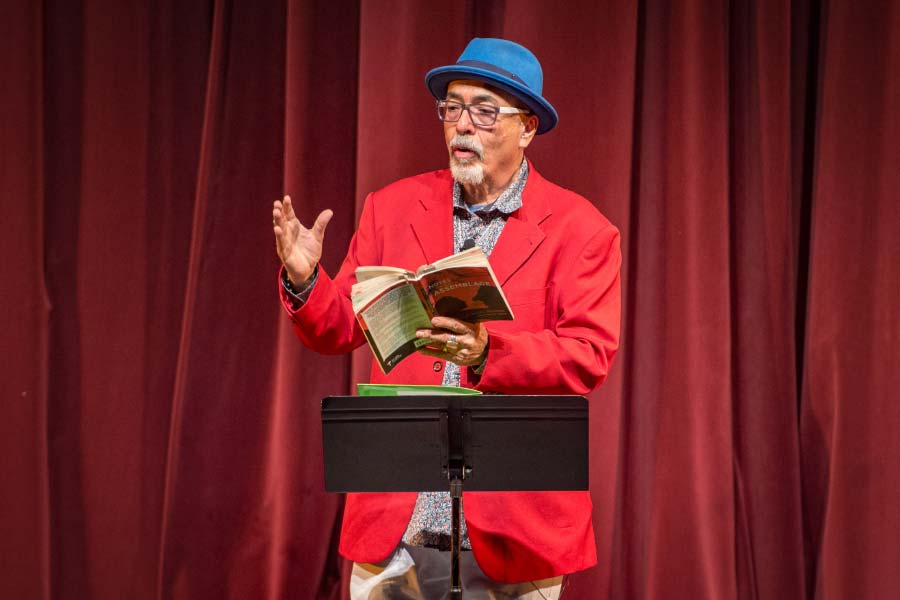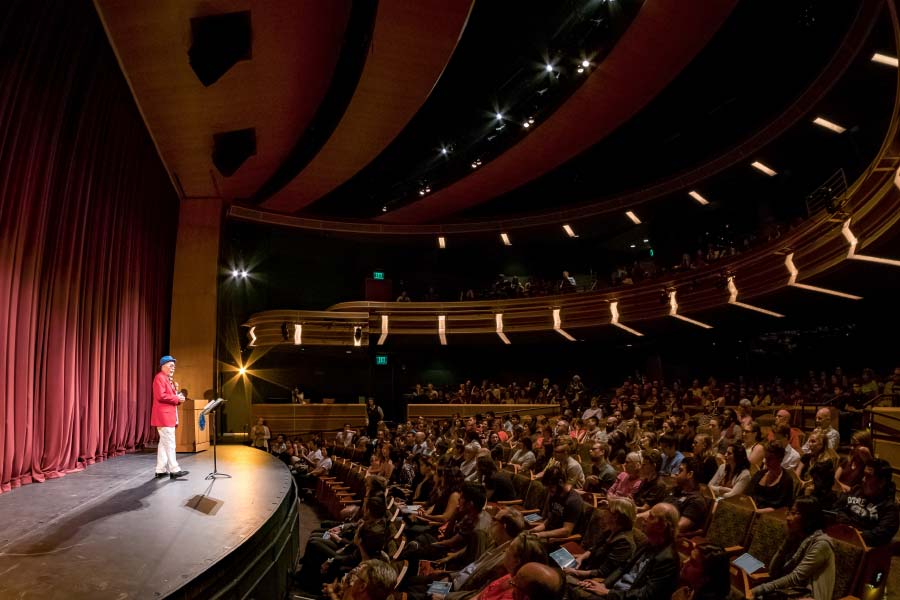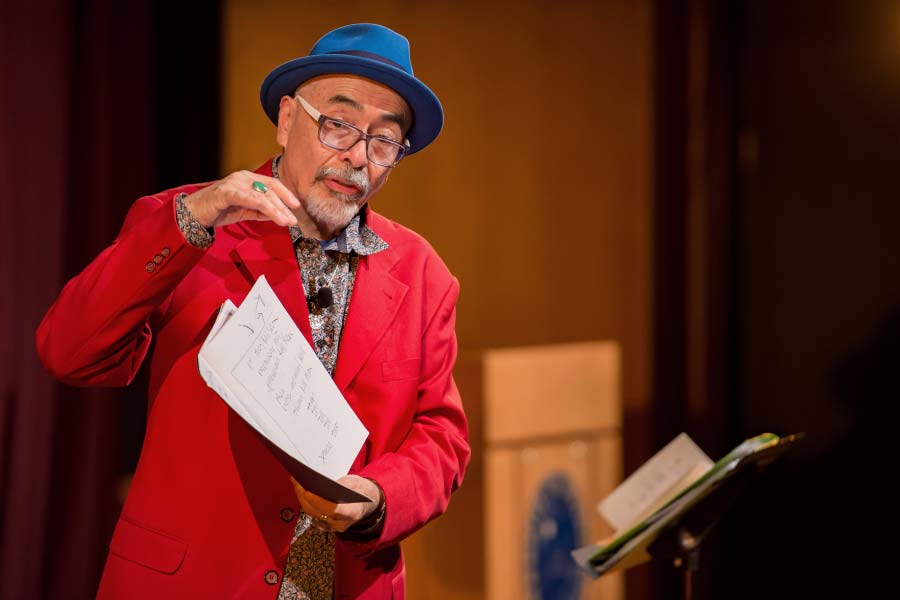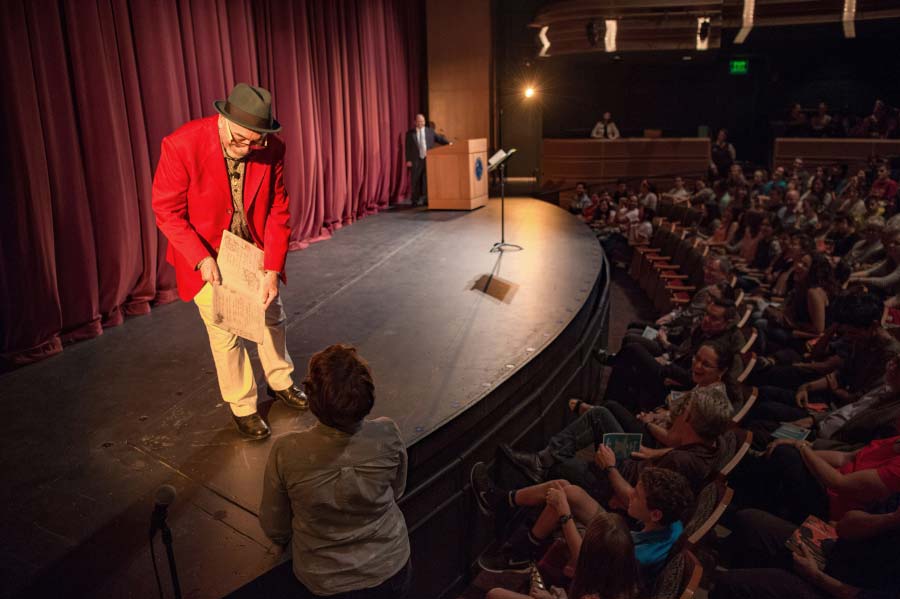Juan Felipe Herrera can’t trace a straight path from his childhood as the son of itinerant Mexican farmhands roaming southern California to his current post as poet laureate of the United States. But he knows that it involves crossing borders and smashing through barriers, bouncing between beatnik coffee shops and academic ivory towers, and bringing disparate people together around the spoken and written word.
He recalls his childhood in fleeting images, poetic splashes on an open landscape. The small house his father built on top of a vehicle so they could move with the harvest. The joy of eating fried tortillas with brown sugar at a fiesta hidden in the mountains near Escondido. The fear caused by Border Patrol agents snatching and deporting a family in the night.
His father learning English by paying a penny per word to fellow workers. His mother, the dancer and singer, buying him magazines and books when they couldn’t afford it. The family “on the road, day and night, nonstop forever.” He wonders if he continued their late 1800’s lifestyle of picking up and doing something different whenever the spirit moved him.
“If you could do a zigzag on the wall, a thousand zigzag routes, that would be my path,” Herrera said over the phone last month. “I never knew where I was going because I never thought I could go anywhere. I was also interested in the present: writing, reading, doing art, working with poets, organizing readings. None of that adds up to a career.”
“I never knew where I was going because I never thought I could go anywhere…"
The path of the nation’s first Latino poet laureate will bring him to the campus of Notre Dame on Oct. 5 and 6 for a poetry reading, reception and visits with students. The career Herrera, 67, never planned has seen him author 28 books of poetry, novels for young adults and collections for children, including “Half the World in Light: New and Selected Poems” (2008), winner of the National Book Critics Circle Award. He has received fellowships from the National Endowment for the Arts and the Guggenheim Foundation and two Latino Hall of Fame Poetry Awards. He served as poet laureate of California from 2012 until the Library of Congress appointed him to the nation’s highest honor in poetry in 2015. Previous laureates include Robert Frost, Elizabeth Bishop, Robert Penn Warren and Gwendolyn Brooks.
Events Open to the Public
Poetry Reading
Time: Wednesday, October 5, 7:05 p.m. – 8:30 p.m.Location: Patricia George Decio theatre (DPAC)
Welcome remarks by Fr. Jenkins, President of Notre Dame
Reception and Book Signing
Time: Wednesday, October 5, 8:30 p.m. – 9:15 p.m.Location: Main lobby of DPAC
*Events are free but ticketed. Learn more about Juan Felipe Herrera’s visit.
Herrera said his goals in visiting Notre Dame include meeting the students and hearing about their experiences, delivering a poetry reading that connects with people, and inspiring them to cross their own boundaries.
Francisco Aragón, director of Letras Latinas, the literary initiative of the Institute for Latino Studies, spearheaded the effort to bring Herrera to campus based on their personal connection. Herrera has been Aragón’s friend and informal mentor since he was a student at Berkeley and attended poetry readings in the Bay area in the 1980’s. Aragón published Herrera’s poetry in the Berkeley Poetry Review, and later invited him to write the foreword to an anthology of Latino poetry. This term, he’s teaching Herrera’s work at Notre Dame.
“The significance of his visit is tied to why Notre Dame chose to start the Institute for Latino Studies in 1999,” Aragon said. “Seeing the demographic shifts and that most Latinos are Catholic, the Institute was created to shed light on the U.S. Latino experience. Having the first Latino poet laureate here affords an opportunity to deepen that mission because his platform helps get the story out.”
Aragón described Herrera’s poetry as experimental and linguistically challenging, arising from the fields and streets rather than the ivory tower. His explorations of mixed identity and crossing borders, Aragón said, are inclusive because they empower people to find their own voice.
Herrera said his father decided to cross the border at age 14 and make a new life in the United States. The family moved often along the roads of the San Joaquin Valley, and he went to schools from San Diego to San Francisco. That spirit of picking up and learning on the fly characterize his education in poetry, which he mostly taught himself. A second grade teacher’s compliment of his “beautiful voice” inspired him to develop his own and encourage others.
At age 10, he idolized his cousin, a Chicano beatnik who played jazz and lived in a Mission District basement apartment with dark blue walls and mobiles of bones hanging from the ceiling. He played folk music by Bob Dylan as a teenager and graduated from San Diego High in 1967. He recalled performing blues harmonica, badly, at coffee houses with high school friends and reading paperback copies of Zen poetry, Herman Hesse and Jean Paul Sartre.
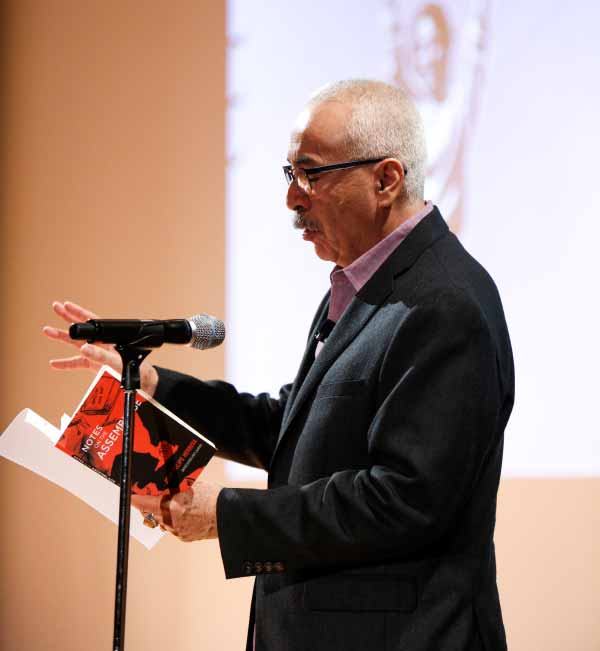 Photo credit: Shawn Miller
Photo credit: Shawn Miller
He was one of the first Latinos to receive an Educational Opportunity Program scholarship to attend UCLA, where he got involved in the Chicano Civil Rights Movement in the 1960’s. He agitated against the Vietnam War, put together street theater and protests, and went to rock concerts by Jimi Hendrix and Janis Joplin. Major influences included beat poet Allen Ginsberg and Luis Valdez, the father of Chicano theater.
“I was doing all those things, all at the same time, and none of them led to the poet laureate of the United States,” he said. “I took a million detours.”
The zigzags went wider as a professional, working at a cultural center, applying for artists’ grants and organizing literary readings. He lived on as little as $50 a month. He received a masters in Social Anthropology from Stanford in 1980 but wouldn’t take his first formal poetry courses at the Iowa Writer’s Workshop until nearly two decades after college. He earned his masters in fine arts there in 1990 and has since jumped in and out of the world of academia.
“That was great for me to learn with the right hand what I’d already learned with the left hand in the street and cafes,” Herrera said. “Crossing borders from the street shop to the workshop.”
Introduced to structure and the formal canon of poets in English, he became convinced that street and spoken poets could learn from them as he had – and the other way around. Much of his poetry springs from performance, bilingual language and dialects, and the spoken word – he calls these poems “undocuments.” He has since taught creative writing at many universities, especially the University of California, Riverside.
“Crossing over is significant,” he said. “Those large trembling universes need to really pour into each other.”
In “blood gang call,” he writes:
Calling all tomato pickers, the ones wearing death frowns instead of jackets
Calling all orange & lemon carriers, come down the ladder to this hole
Calling all chile pepper sack humpers, you, yes, you the ones with the crucifix
Calling all garlic twisters caught in the winter spell of frozen sputum.
The poetic technique Herrera uses here and often borrows from spoken word and relies on repetition, which he later learned is called anaphora. The incantations reflect his research and travel in indigenous cultures, which often lean on repetition in songs and prayers. He said he doesn’t begin with anaphora but likes the effect.
“It’s very powerful, visceral, participatory, and very spiritual,” he said. “I like it because it’s quick. I’m a very feverish writer. I don’t really come up with an idea for what I write. It’s usually like a thread that you start to sew a garment with. A lightning bolt. That’s what I begin to feel, a little thread going through me, and it’s as powerful as a baby lightning bolt. It’s just an inspiration and I can feel it moving and that’s when I have to run and write.”
The goal is often to explore in words the different meanings of American identity. When Herrera was appointed poet laureate, James Billington, the Librarian of Congress, made reference to the work of Walt Whitman, the canonical poet synonymous with creating the new American identity.
“I see in Herrera’s poems the work of an American original—work that takes the sublimity and largesse of ‘Leaves of Grass’ and expands upon it,” Billington said. “His poems engage in a serious sense of play—in language and in image—that I feel gives them enduring power. I see how they champion voices, traditions and histories, as well as a cultural perspective, which is a vital part of our larger American identity.”
Herrera said he is humbled by the comparison to Whitman. His lifelong project, he said, is to write about who we are and what everybody is doing. As he sees it, writing the particulars of an individual’s stories is a way to prevent being washed away in the “generalized, homogenized corporate tidal wave of America.”
“We are all kind of writing America, whether we are critics or poets or essay writers or just living every day,” he said. “We’re continuously writing America, and it’s a beautiful thing to do. We need to know what your America is.”
“...I hope to inspire them to continue to be creative, to step forth and cross boundaries and see it’s a big world. Most of all it’s about coming together with the community.”
Juan Felipe Herrera
As poet laureate of California, Herrera created a two-year project to collect submissions of poetry from everybody who wanted to contribute a line or phrase and combine it into a “rolling wave of poetry.” He titled it, “The Most Incredible and Biggest and Most Amazing Poem on Unity in the World.”
As national poet laureate, he often finds himself drawn to specific events in the news. He has written eulogies for victims of gun violence, police shootings and terrorism. Aragón said he plans to teach a recent Herrera poem and performance dedicated to the victims of the Orlando nightclub attack. “It’s about finding a voice at a time when we need healing,” Aragón said.
Herrera said the laureate stage continues to get bigger. It’s an opportunity to meet and learn from different viewpoints. He said he draws inspiration from his visits, recalling an 11-year old Californian who writes about the abandoned children deportations leave behind, and young people in Wisconsin passionate about climate change. It’s an opportunity to reflect on how people can connect with different languages and cultures.
“I’m excited about visiting Notre Dame,” he said. “With my poetry, I hope to deliver something that’s relevant for them. And I hope to inspire them to continue to be creative, to step forth and cross boundaries and see it’s a big world. Most of all it’s about coming together with the community.”
